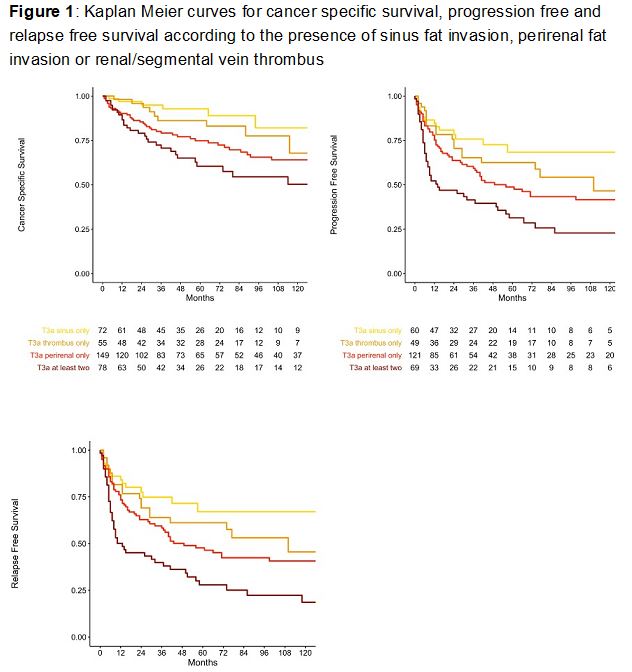Back
Poster, Podium & Video Sessions
Moderated Poster
MP12: Kidney Cancer: Advanced (including Drug Therapy) I
MP12-06: Oncologic outcomes in patients diagnosed with pT3aN0M0 renal cell cancer according to renal vein thrombus or fat invasion
Friday, May 13, 2022
1:00 PM – 2:15 PM
Location: Room 222
Giuseppe Fallara, Giuseppe Rosiello, Andrea Necchi, Daniele Raggi, Walter Cazzaniga, Alberto Martini, Giuseppe Basile*, Daniele Cignoli, Gianmarco Colandrea, Gianfranco Baiamonte, Federico Belladelli, Giacomo Musso, Francesco Cei, Cristina Giancristofaro, Andrea Ieva, Daniela Canibus, Alberto Briganti, Roberto Bertini, Francesco Montorsi, Andrea Salonia, Alessandro Larcher, Umberto Capitanio, Milan, Italy

Giuseppe Basile, MD
IRCCS San Raffaele Hospital
Poster Presenter(s)
Introduction: The natural history of patients with pT3a non-metastatic renal cell carcinoma (RCC) is extremely heterogeneous. After KEYNOTE 564 trial report, such heterogeneity has special implications for follow-up schedule and enrollment in trial testing adjuvant agents. Thus, the aim of the study is to investigate the differential prognosis of pT3a subtypes.
Methods: From a single institutional prospective database, 426 consecutive patients treated with radical nephrectomy for pT3aN0M0 RCC were selected. Patients were stratified according to pT3a subtype as perirenal fat invasion only, sinus fat invasion only, segmental or renal vein thrombus only or at least two of these features. Cancer specific survival (CSS), progression free survival (PFS, e.i. only distant metastases) and relapse free survival (RSF, e.i. local and/or distant progression) were analyzed with Cox regression models adjusted for tumor size, presence of necrosis and sarcomatoid features, and grade.
Results: Overall, 65 (15%) patients presented with renal/segmental vein thrombus only, 177 (42%) with perirenal fat invasion, 91 (21%) with sinus fat invasion and 93 (22%) with at least two of these features. At a median follow up of 5.4 years, 140 (33%) patients had distant progression, 18 (4%) local recurrence and 88 (21%) died due to RCC. PFS, RFS and CSS in case of more than one pT3a feature compared to patients with only one feature (Fig.1). The presence of at least two pT3a features was associated with a higher risk of progression (HR 2.20; 95%CI 1.21-3.98; p-value=0.009), recurrence (HR 2.26; 95% CI 1.26-4.08; p-value=0.007) and cancer specific mortality (HR 3.23; 95% CI 1.32, 7.90; p-value=0.01) compared to the presence of only one pT3a feature. Moreover, the presence of perirenal fat invasion was associated to a lower CSS (HR 2.64; 95%CI 1.11, 6.25; p-value=0.03) compared to the presence of sinuous fat invasion or tumoral thrombus only.
Conclusions: The concurrent presence of perirenal and/or sinus fat invasion and/or renal/segmental thrombus determined a higher risk of progression, relapse and cancer specific mortality, but also the presence of perirenal fat invasion harbors slightly poorer outcomes relative to sinus fat invasion or tumoral thrombus only. These findings could improve candidate selection for adjuvant therapy.
Source of Funding: no

Methods: From a single institutional prospective database, 426 consecutive patients treated with radical nephrectomy for pT3aN0M0 RCC were selected. Patients were stratified according to pT3a subtype as perirenal fat invasion only, sinus fat invasion only, segmental or renal vein thrombus only or at least two of these features. Cancer specific survival (CSS), progression free survival (PFS, e.i. only distant metastases) and relapse free survival (RSF, e.i. local and/or distant progression) were analyzed with Cox regression models adjusted for tumor size, presence of necrosis and sarcomatoid features, and grade.
Results: Overall, 65 (15%) patients presented with renal/segmental vein thrombus only, 177 (42%) with perirenal fat invasion, 91 (21%) with sinus fat invasion and 93 (22%) with at least two of these features. At a median follow up of 5.4 years, 140 (33%) patients had distant progression, 18 (4%) local recurrence and 88 (21%) died due to RCC. PFS, RFS and CSS in case of more than one pT3a feature compared to patients with only one feature (Fig.1). The presence of at least two pT3a features was associated with a higher risk of progression (HR 2.20; 95%CI 1.21-3.98; p-value=0.009), recurrence (HR 2.26; 95% CI 1.26-4.08; p-value=0.007) and cancer specific mortality (HR 3.23; 95% CI 1.32, 7.90; p-value=0.01) compared to the presence of only one pT3a feature. Moreover, the presence of perirenal fat invasion was associated to a lower CSS (HR 2.64; 95%CI 1.11, 6.25; p-value=0.03) compared to the presence of sinuous fat invasion or tumoral thrombus only.
Conclusions: The concurrent presence of perirenal and/or sinus fat invasion and/or renal/segmental thrombus determined a higher risk of progression, relapse and cancer specific mortality, but also the presence of perirenal fat invasion harbors slightly poorer outcomes relative to sinus fat invasion or tumoral thrombus only. These findings could improve candidate selection for adjuvant therapy.
Source of Funding: no

.jpg)
.jpg)